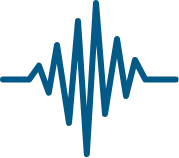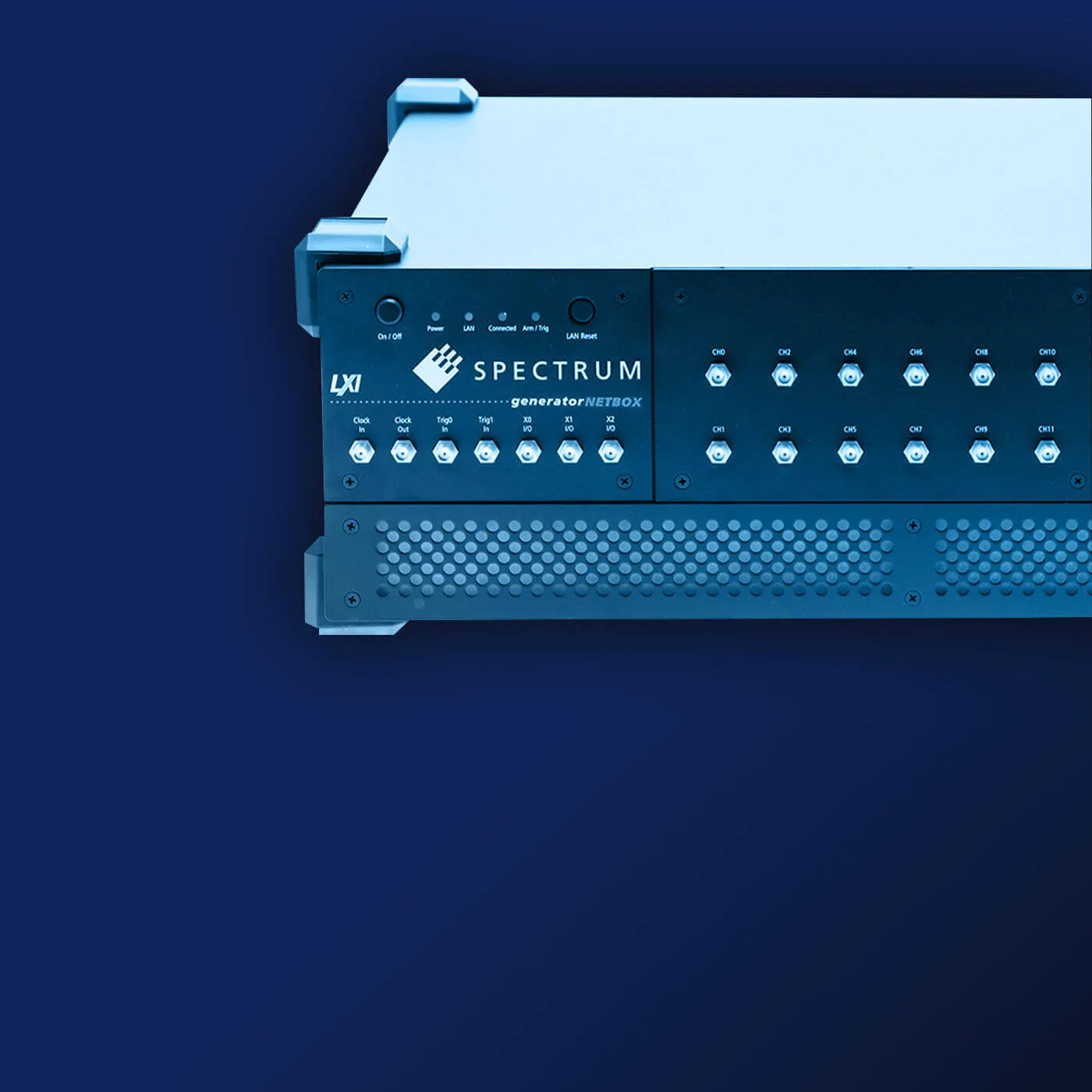
Acoustics
The measurement and analysis of sound waves traveling in air, solids and liquids is important to a number of industries involved in production test, machine/engine performance and process control. Signals detected by sensors such as microphones and accelerators can reveal critical information about an objects behavior and action. Sound waves can also be used for acoustic location with active techniques employing sound generation and studying echo responses while passive methods listen for generated sounds or vibrations and then endeavor to determine the direction and location of the source. Perhaps the most famous acoustic location method is SONAR where hydrophones are be used to monitor waveforms traveling in water. However, acoustic location is also employed in other mediums and plays a key role in material science and geology.
Learn more

Aerospace
The aerospace industry utilizes an extensive array of technologies in its constant quest to improve vehicle control, efficiency, range, payload and lifetime. Materials science, communications, aeronautics and engine/propulsion technologies are all critical fields of research and each use electronic signal testing to help determine performance. For example, in material science new products and compounds need to be characterized and qualified to understand how they will perform in different situations. To do this engineers subject the materials to numerous tests to find out their behavior under various conditions such as stress, strain, vibration and temperature. Sensors for key parameters such as strain, force, and acceleration produce electronic signals that all need to be captured and measured. Other technologies such as ultrasound, laser and radio waves may also be used to assist in observing the behavior of the material as it undergoes destructive or non-destructive testing.
Learn more

Astronomy
Even though it is one of the oldest scientific disciplines astronomy remains at the cutting edge of technology and engineering. Once limited to the the observation of visible light, mostly in the night time sky, the 20th century saw the development of a host of new methods for exploring the cosmos. Using instrumentation sensitive to an ever expanding part of the electromagnetic spectrum scientists have been able to detect a host of previously unknown phenomena and look further into space than ever before. Radio telescopes were developed revealing the remnants of exploding stars while even higher energy instruments, like those using X-rays and gamma rays, made it possible to study the behavior of matter in extreme states, such as those found in pulsars and blazars.
Learn more

Automated Test Equipment
Computer controlled testing has helped to drive manufacturing productivity by increasing efficiency and improving quality. Automated test equipment (ATE) plays a crucial role as it enables more vigorous testing at faster rates and in a more controlled manner than was previously possible using manual procedures. ATE can involve a single measurement made continuously at very high rates or multiple measurements made by a host of different instruments. Measurements made on a device under test (DUT) or unit under test (UUT) are typically calculated, stored and analyzed in an automated fashion by some form of computer. The process helps to remove human error and allows fault diagnosis to be performed in reproducible manner even when sophisticated measurements are involved.
Learn more

Automotive
For over a century automobiles have been evolving as manufacturers constantly find ways to improve vehicle handling, efficiency, safety and performance. A key driver of these developments is electronics and electronic signal testing. In recent years the increased use of microprocessors, fast communications and sensor technology has led to advancements in breaking systems, traction control, and even accident avoidance. Modern cars now use electronic ignition systems to improve their performance and efficiency and some vehicles employ electronic motors, or hybrid designs, to help reduce the reliance on traditional engine fuels. Safety remains an industry priority and manufacturers undergo an extensive array of tests and inspections throughout the production process to ensure quality remains at satisfactory levels. Robotics is extensively used in the manufacturing process helping to speed up production, reduce costs and eliminate problems associated with human error.
Learn more

Big Physical Experiments
The mission to understand matter and the forces of nature continue to drive ever larger and more complex experiments in the scientific field of physics. Major efforts are being undertaken to explore the cosmos, determine the properties of matter and harness the forces that flow within our universe. In order to do this scientists and engineers are constructing machines and instruments that are larger, more powerful and more sensitive than ever before.
Learn more

Communications
Electronic communication continues to evolve as the world community continues to demand the transfer of more information at ever increasing speeds. Analog and digital technology is used in both point-to-point and broadcast communications that are being delivered by wireless, fiber optic and cable network systems. In order to develop and maintain these systems engineers need to be able to test and qualify the signals being received and transmitted. Signal loss or attenuation needs to be reduced, noise monitored and key parameters characterized. Furthermore, as systems become ever more complicated sources of error need to be detected quickly and corrected.
Learn more

Fiber Optics
Optical fibers are increasingly used in a diverse range of applications. Their ability to transmit information at light speed over long distances and with low loss has made them the primary medium for large volume long range data communication. As such, fiber optic networks can be found in telecommunications systems where they are used for transmitting and receiving purposes. They are also used to deliver a variety of digital services such as internet, HDTV, and video on-demand.
Learn more

High Voltage Testing
High voltage is found in a wide variety of places including power distribution networks, components that detect light or particles (for example photo-multipliers and electron multipliers), components that emit light or particles (such as halogen globes, and cathode ray tubes), transformers, high powered receivers and transmitters, automotive ignition systems as well as in a variety of natural occurring phenomena like lightening and objects that exhibit electrostatic behavior. The use and study of high-voltage is important as it is crucial to the understanding how electricity can be transmitted, a key parameter in power distribution, as well as how components perform under different conditions.
Learn more

Laser Applications
The unique characteristic of laser light is that it is highly coherent. High spatial coherence means that laser beams can be focused into small spots and collimated beams can travel vast distances with minimal dispersion. Lasers can also produce light that is high in temporal coherence. This means the emitted light has a narrow spectrum or is of a single color. Temporal coherence also makes it possible to produce pulses that are narrow, with the fastest lasers being able to produce pulses that go down into the femtosecond range. The unique quality of laser light has resulted in lasers now being used in an increasing number of applications. This includes fields as diverse as science, medicine, communications, chemistry, printing, data storage, imaging, welding, robotics, surveying, mapping, guidance and cutting.
Learn more

Lidar Applications
Light detection and ranging (LIDAR) systems use reflected laser signals to determine an objects position and its characteristics. In its simplest form LIDAR uses "time of flight", the time it takes for a laser signal to reach and return from an object, to accurately measure distances. However, LIDAR systems can also examine other properties of the reflected light, such as its frequency content or polarization, to reveal additional information about the object. As such, LIDAR systems are now being developed and employed in an ever expanding number of application areas such as autonomous driving and vehicle tracking, geological and geographical mapping, seismology, meteorology, atmospheric physics, surveillance, altimetry, forestry, navigation, and even environmental protection.
Learn more

Materials Science
Since the dawning of the industrial revolution humans have looked to advances in Material Science to help them obtain superior products with improved performance and/or lower cost. Traditionally, this has been achieved by the application of developments in Physics, Chemistry and Engineering that have enabled dramatic advances in the properties of materials such as metals, ceramics, composites, polymers and semiconductors. In more recent times Materials Science has even expanded into the realms of nanotechnology and biological materials (or biomaterials).
Learn more

Medical Science
Digitizers are playing an increasing role in medical science particularly when fast electronic signals such as those encountered when using ultrasound, lasers and radiation need to be acquired, analyzed and displayed. The ability of digitizers to convert these types of analog signals into digital information which can then be transferred at high-speeds into computers makes them ideal whenever the information needs to be analyzed and quickly presented. Fast medical imaging is being used to improve diagnosis and help detect disease in the fields of radiology, nuclear medicine, ultrasonography, magnetic resonance imaging (MRI), optical coherence tomography (OCT) and photo-acoustic imaging, dosimetry, positron emission tomography (PET) and other related non-invasive inspection methods.
Learn more

Nanotechnology
Nanotechnology, a relatively recent development, is already a rapidly expanding applied science. Breakthroughs in the late 20th century, particularly in the field of surface imaging at the atomic level, have enabled scientists and engineers to make significant technological advances in a diverse range of industrial sectors. This includes, communications, food science, medicine, microelectronics, environmental science, biology, transportation, energy, aerospace, and much more.
Learn more

Quantum Computing
The study of quantum science, particularly quantum information science, is an area of research that has seen a rapid increase in activity since the beginning of the 21st century. The field of investigation promises enormous advancements in technology that may have a profound effect on the way we perform the future operations of computing and communications. By exploiting the principles of quantum mechanics scientists are studying the behavior of qubits, quantum bits of information, as they are subjected to different physical conditions. Instrumentation such as arbitrary waveform generators (AWGs) and digitizers play a crucial part in process. AWGs allow the generation of an almost unlimited range of waveforms that can be used to produce electromagnetic signals in the radio-wave range that in turn stimulate or resonate the materials being studied. While digitizers allow the capture and rapid analysis of resulting signals that reveal the qubit behavior.
Learn more

Radar Applications
Technology advances in hardware and software has seen radar employed in an ever increasing range of commercial and military applications. While radar still remains a key technology for the monitoring of aircraft and ships, miniaturization and cost reduction has seen the technology move into many new applications areas including those in the automotive industry, security, non-destructive inspection, meteorology, archeology, mining and surveying.
Learn more

Semiconductor Tests
Modular Digitizers, Arbitrary Waveform Generators (AWG's) and pattern generators are rapidly becoming instruments of choice for the automated testing systems used for semiconductor device characterization. Small and compact these multi-channel products are available from Spectrum in a variety of popular standards including PCI, PCIe, PXI, cPCI and LXI. They offer bandwidths from 50 kHz to 1.5 GHz, sampling rates from 100 KS/s to 5 GS/s, and resolution from 8 up to 16 bits. To enable easy integration into ATE systems Spectrum includes software and instrumentation drivers that work with 32 bit and 64 bit versions of Windows and Linux. Programming of the cards is possible using a wide range of languages such as LabVIEW, LabWindows/CVI, C++, MatLab, Borland Delphi, Visual Basic, VB.NET, C#, J# and IVI.
Learn more

Spectroscopy
Mass spectrometry is an analytical technique used to identify the chemical composition of a sample. The method typically works by bombarding a sample with electrons and breaking it into charged molecules or molecule fragments. These ionized particles are then separated, normally by accelerating them in an an electromagnetic field, and the mass to charge ratio for each compound is then determined. To detect the ionized particles an electron multiplier is normally used and the results are displayed as a spectra which plots the number of detected ions as a function of their mass to charge ratio. The electron multiplier plays a crucial role in detecting the ions and producing the electrical signals that need to be analyzed.
Learn more

Ultrasound
The use of Ultrasonic products is increasing as new techniques and improvements in instrument performance constantly expand the range of applications. Spectrum digitizers are ideal tools for making ultrasonic measurements and can play a key role required in the development, testing and operation of these products. Spectrum digitizers and arbitrary waveform generators offer a wide range of bandwidths, sampling rates, and dynamic range to match the broad spectrum of ultrasonic measurement needs. When wide dynamic range and maximum sensitivity is required high-resolution 14 and 16 bit digitizers are available for capturing and analyzing ultrasonic signals from 100 kHz up to 250 MHz in frequency. A cost effective range of 8 bit digitizers is also available to cover frequency ranges from 5 MHz up to 1.5 GHz. Typical ultrasound applications include Non-Destructive Testing (NDT), Ultrasonic Testing (UT), Doppler Effect Flow-meters, Time-of-flight Diffraction (TOFD), Range Finding, Scanning Acoustic Microscopy (SAM) and Tomography (SAT), Medical Sonography and Ultrasonography, Phased array ultrasonics, Laser ultrasonics and Acoustic Emission.
Learn more



































